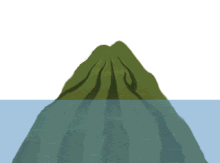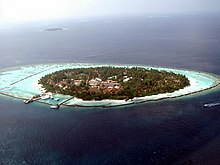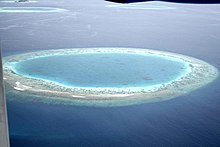Fringing reef

A fringing reef is one of the three main types of coral reef recognized by most coral reef scientists. It is distinguished from the other main types (barrier reefs and atolls) in that it has either an entirely shallow backreef zone (lagoon) or none at all. If a fringing reef grows directly from the shoreline (see photo, right) the reef flat extends right to the beach and there is no backreef. In other cases (e.g., most of the Bahamas), fringing reefs may grow hundreds of yards from shore and contain extensive backreef areas with numerous seagrass meadows and patch reefs.
This type of coral reef is the most common type of reef found in the Caribbean and Red Sea. Darwin believed that fringing reefs are the first kind of reefs to form around a landmass in a long-term reef growth process.[1]
Barrier reef
Sometimes it is hard to tell the difference between fringing reefs and another type of reef called a barrier reef. One of the ways that these two types of reefs are separated is based on the depth of the lagoon in the back reef. Barrier reefs have at least some deep portions; fringing reefs do not. Another major difference is that barrier reefs tend to be much farther away from shore than fringing reefs.[1]
Structure

There are two main components that make up a fringing reef, the reef flat and the reef slope.
Reef flat (back reef)
The reef flat is the shoreward, flat, broadest area of the reef. The reef flat is found in fairly shallow water, and can be uncovered during low tide. This area of the reef is only slightly sloped towards the open ocean.[2]
Since the reef flat is adjacent or nearly adjacent to land, it sustains the most damage from runoff and sediments. Typically, few of the flat's corals are alive. Seagrasses, seaweeds, and soft corals are often found there.[2]
Reef slope (fore reef)
The reef slope is found at the outer edge of the fringing reef, closest to the open ocean. This area of the reef is often quite steep and descends either to a relatively shallow sand bottom or to depths too great to allow the growth of coral.[2]
Coral grows much more abundantly on this slope, both in numbers and in species diversity. This is mostly because runoff and sediments are less concentrated here. Greater wave action disperses pollutants and carries nutrients to this area.[2] In addition a common feature on the fore reef is spur and groove formations which transport sediment downslope in the groove.
The upper portion of this slope is called the reef crest. The crest has the best balance between sunlight and waves, so coral grows fastest here. The base of the slope receives the least sunlight and has the least growth out of the whole slope.[2]
Location of fringing reefs
Fringing reefs are located near shore in the tropics in many areas and are the most common reef type. Coral reefs are found in the tropics in which the water is between 18 and 30 °C (64 and 86 °F).[3]
Many of the Great Barrier Reef's components are actually fringing reefs. Of the close to 3400 individual reefs, 760 are actually fringing reefs.[4]
Near Msambweni, Kenya the reef, which stretches from Msambweni to Malindi in the north, is the world's largest continuous fringing reef.[5]
Reef growth



Keep-up: These reefs grow at the same rate that sea level rises.[1]
Catch-up: These reefs initially grow more slowly than sea level rises, but eventually catch up when the rise in sea level slows or stops.[1]
Give-up: These reefs are not able to grow fast enough and are "drowned out".[1]
Reef development
The most important determinant of reef growth is available space as determined by sea level changes. Sea level changes are mostly due to glaciation or plate tectonics. There are six different major ways in which fringing reefs grow and develop.[1]
- Reefs can develop vertically as far as the space below the surface allows. The reef generally grows upward from a starting point towards the surface. Once the reef crest reaches sea level the reef may begin growing seaward. Growth begins after flooding, mostly from parts of the reef that have died. Because the reef grows upward, the oldest sediments are found lower in the reef. The reef flat's age indicates when the reef reached sea level. Catch-up reefs have younger surfaces than keep-up reefs of this type.
- Reefs can expand seaward from the shore. This requires a fairly constant sea level. If the sea level drops, the reef flat in more seaward areas slopes downward.
- Reefs can grow atop muddy sediments which can predate the reef or accrete along with the reef's growth. These reefs also grow seaward from the shore. Older sediments are closest to shore and are not buried. Coral, seagrass and algae filter sediment before it is placed on the reef crest.
- Reefs can form in a gradual, sporadic manner, with alternate vertical and horizontal growth episodes. In this type of fringing reef formation there are multiple separate reefs that are found parallel to the shore and the original fringing reef. These reefs become a single, large reef when reef sediments fill in the spaces between the different reefs.
- Reefs can develop when an offshore reef grows to sea level forming a barrier. When the crest grows faster than the flat, a lagoon forms. The lagoon then fills with inshore sediments.
- Offshore reefs can form their barrier using storms to move coral and other debris inwards. The recurring storms continually reshape the seaward side of such reefs.
Effect of tectonic activity
Tectonic activity can have very detrimental effects. An earthquake on Ranongga Island in the Solomon Islands moved 80% of its fringing reef permanently above sea level. Northern reefs became elevated 1m above the high tide water height, whereas on the south side reefs moved 2 to 3m above the water height.[6]
Threats
As with other types of reefs, there are many reasons of fringing reef destruction, such as:
- Destructive fishing practices: These include cyanide fishing, blast or dynamite fishing, bottom trawling, and muro-ami (banging on the reef with sticks). Bottom-trawling is one of the greatest threats to cold-water coral reefs.
- Over-fishing: This affects the ecological balance of coral reef communities, warping the food chain and causing effects far beyond the directly overfished population.
- Careless tourism: Careless boating, diving, snorkeling, and fishing happens around the world, with people touching reefs, stirring up sediment, collecting coral, and dropping anchors on reefs. Some tourist resorts and infrastructure have been built directly on top of reefs, and some resorts empty their sewage or other wastes directly into water surrounding coral reefs.
- Marine pollution: Urban and industrial waste, sewage, agrochemicals, and oil pollution are poisoning reefs. These toxins are dumped directly into the ocean or carried by river systems from sources upstream. Some pollutants, such as sewage and runoff from farming, increase the level of nitrogen in seawater, causing an overgrowth of algae, which 'smothers' reefs by cutting off their sunlight.
- Sedimentation: Erosion caused by construction (both along coasts and inland), mining, logging, and farming is leading to increased sediment in rivers. This ends up in the ocean, where it can 'smother' corals by depriving them of the light needed to survive. The destruction of mangrove forests, which normally trap large amounts of sediment, is exacerbating the problem.
- Coral mining: Live coral is removed from reefs for use as bricks, road-fill, or cement for new buildings. Corals are also sold as souvenirs to tourists and to exporters who don't know or don't care about the longer term damage done, and harvested for the live rock trade.
- Climate change: Corals cannot survive if the water temperature is too high. Global warming has already led to increased levels of coral bleaching, and this is predicted to increase in frequency and severity in the coming decades. Such bleaching events may be the final nail in the coffin for already stressed coral reefs and reef ecosystems.
Species diversity
The backreef area has the least species diversity, which increases seaward towards the reef crest. Some of this difference is due to eutrophication from increased nutrients, sediments and toxicity due to domestic and industrial wastes.[7]
More macrophytes live on the bottom due to the increases in nutrients. They also feel that this increase in nutrients has caused an increase in the number of phytoplankton that are present above the coral reef. The increase in phytoplankton has led to reduced light reaching the coral species and has also led to a greater number of larger invertebrates to be found.[7]
The sediments that are present within the environment cause increased turbidity and may smother some organisms. The corals present on the fringing reefs use four processes to get rid of sediments which include polyp distension, tentacular movement, ciliary action and mucus production. The corals that are present then are thus likely those that can get rid of the sediments the best.[7]
Bloodling also known as brooding corals have higher growth and reproduction rates than others.[7]
In the area of the reef closest to the shore there is generally a lot of fleshy algae which forms on sand and coral rubble. These types of algae include Lyngbia sp. and Oscilatoria sp.[7]
Over recent years the dominant species in the reef flat have been affected by environmental changes. On fringing reefs in Barbados, species such as Diploria strigosa, Palythoa mamillosa, and Diadema antillarum are found.[7]
The reef crest's most common species is Porites porites, a type of stony coral, although there are also significant areas covered in flesh-like algae.[7]
See also
References
- ^ a b c d e f Kennedy, D.M. and Woodroffe, C.D. 2002.Fringing reef growth and morphology: a review. Earth-Science Reviews. 57:255-277.
- ^ a b c d e Castro, Peter and Huber, Michael E. 2008. Marine Biology. 7ed. McGraw-Hill, New York
- ^ Zubi, Teresa. 2007. Ecology, Coral Reefs. http://www.starfish.ch/reef/reef.html Accessed on March 30, 2008
- ^ Australian Museum. 2004. geoscience: the Earth, Great Barrier Reef. http://www.amonline.net.au/geoscience/earth/barrier_reef.htm Accessed on March 30, 2008.
- ^ McClanahan, T. R.; Young, T. P. (1996). East African Ecosystems and Their Conservation. New York: Oxford University Press. p. 70. ISBN 978-0-19-510817-0.
- ^ Albert, U., Udy, J., Baines, G. and McDougall, D. 2007. Dramatic tectonic uplift of fringing reefs on Ranongga Is., Solomon Islands. Coral Reefs 26:983.
- ^ a b c d e f g Tomascik, T. and Sander, F. 1987. Effects of eutrophication on reef-building corals: II. Structure of scleractinian coral communities on fringing reefs, Barbados, West Indies. Marine Biology. 94:53-75

